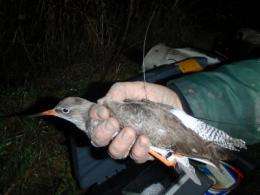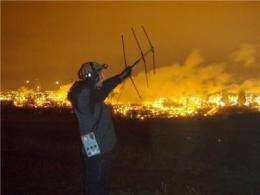Ecologists shed new light on effects of light pollution on wildlife

Coasts and estuaries are among the most rapidly developing areas on Earth. Night-time satellite images of the planet show that except Antarctica, continents are ringed with halos of brightly-lit human development. But coasts are also key wildlife sites. Every year, millions of waterbirds arrive from the Arctic to overwinter on UK coasts, yet scientists remain largely in the dark about how these birds respond to the bright lights of coastal cities and industry.
To shed light on the issue, Dr Ross Dwyer and colleagues from the University of Exeter investigated how artificial light affected feeding habits of the common redshank in the Forth estuary, one of Scotland's most industrialised coasts. As well as major industry such as Grangemouth oil refinery and Longannet power station, whose lights and gas flares illuminate the intertidal areas at night, the estuary's pristine salt marsh and mudflats are home to hundreds of thousands of migrating birds each winter.
Dr Dwyer measured the amount of artificial light in the Forth estuary at night using satellite images from the US Air Force. Although they have been previously used to study electrical power consumption, this is the first time such US military data has been used in animal behaviour research.

He then worked out how the light affected the birds' foraging behaviour by attaching tiny radio transmitters to the backs of 20 redshanks. The devices monitored the birds' location and contained posture sensors to detect how often the birds put their heads down to feed.
Generally, redshanks need to forage day and night during the winter to find enough food. These birds usually forage by sight during the day, which provides them with the most food, and less efficiently at night by locating prey by touch using their bills.
The study found that artificial light had a major impact on how redshanks searched for food, allowing them to forage more efficiently. At night, birds in brightly-lit areas foraged for longer and foraged by sight, rather than touch, compared with birds under darker night skies.
According to Dr Dwyer: "Artificial light from industrial areas strongly influenced the foraging strategy of our tagged birds. It was as if the 24-hour light emitted from lamps and flares on the Grangemouth oil refinery site created, in effect, a perpetual full moon across the local inter-tidal area which the birds seemed to capitalise on by foraging for longer periods at night and switching to a potentially more effective foraging behaviour to locate prey."
The results contrast with other studies, which have found adverse effects of light pollution on wildlife. Previous research found artificial light caused newly-hatched turtles to head away from the sea, rather than towards it, and caused seabirds such as petrels to collide with lighthouses and other lit structures.
More information: Ross Dwyer, Stuart Bearhop, Hamish Campbell and David Bryant (2012). 'Shedding light on light: benefits of anthropogenic illumination to a nocturnally foraging shorebird', doi: 10.1111/1365-2656.12012, is published in the Journal of Animal Ecology on Wednesday 28 November 2012.
Journal information: Journal of Animal Ecology
Provided by Wiley


















